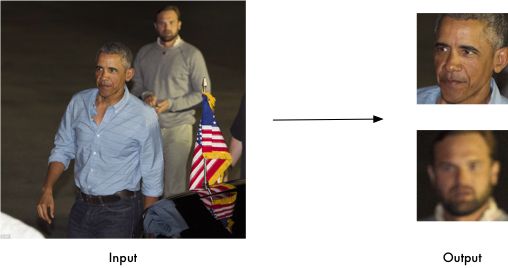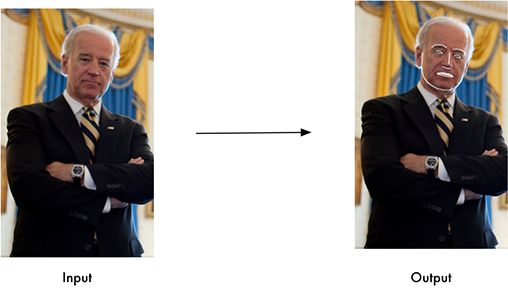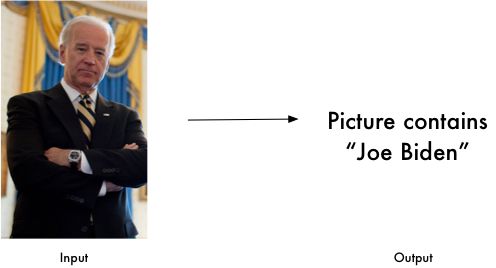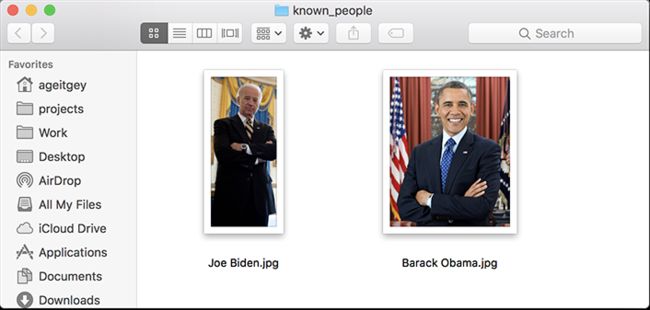Face Recognition
Recognize and manipulate faces from Python or from the command line with
the world's simplest face recognition library.
Built using dlib's state-of-the-art face recognition
built with deep learning. The model has an accuracy of 99.38% on the
Labeled Faces in the Wild benchmark.
This also provides a simple face_recognition command line tool that lets
you do face recognition on a folder of images from the command line!
Features
Find faces in pictures
Find all the faces that appear in a picture:
import face_recognition
image = face_recognition.load_image_file("your_file.jpg")
face_locations = face_recognition.face_locations(image)
Find and manipulate facial features in pictures
Get the locations and outlines of each person's eyes, nose, mouth and chin.
import face_recognition
image = face_recognition.load_image_file("your_file.jpg")
face_landmarks_list = face_recognition.face_landmarks(image)
Finding facial features is super useful for lots of important stuff. But you can also use for really stupid stuff
like applying digital make-up (think 'Meitu'):
Identify faces in pictures
Recognize who appears in each photo.
import face_recognition
known_image = face_recognition.load_image_file("biden.jpg")
unknown_image = face_recognition.load_image_file("unknown.jpg")
biden_encoding = face_recognition.face_encodings(known_image)[0]
unknown_encoding = face_recognition.face_encodings(unknown_image)[0]
results = face_recognition.compare_faces([biden_encoding], unknown_encoding)
You can even use this library with other Python libraries to do real-time face recognition:
See this example for the code.
Installation
Requirements
- Python 3.3+ or Python 2.7
- macOS or Linux (Windows not officially supported, but might work)
Installation Options:
Installing on Mac or Linux
First, make sure you have dlib already installed with Python bindings:
- How to install dlib from source on macOS or Ubuntu
Then, install this module from pypi using pip3 (or pip2 for Python 2):
pip3 install face_recognition
If you are having trouble with installation, you can also try out a
pre-configured VM.
Installing on Raspberry Pi 2+
- Raspberry Pi 2+ installation instructions
Installing on Windows
While Windows isn't officially supported, helpful users have posted instructions on how to install this library:
- @masoudr's Windows 10 installation guide (dlib + face_recognition)
Installing a pre-configured Virtual Machine image
- Download the pre-configured VM image (for VMware Player or VirtualBox).
Usage
Command-Line Interface
When you install face_recognition, you get a two simple command-line
programs:
-
face_recognition- Recognize faces in a photograph or folder full for
photographs. -
face_detection- Find faces in a photograph or folder full for photographs.
face_recognition command line tool
The face_recognition command lets you recognize faces in a photograph or
folder full for photographs.
First, you need to provide a folder with one picture of each person you
already know. There should be one image file for each person with the
files named according to who is in the picture:
Next, you need a second folder with the files you want to identify:
Then in you simply run the command face_recognition, passing in
the folder of known people and the folder (or single image) with unknown
people and it tells you who is in each image:
$ face_recognition ./pictures_of_people_i_know/ ./unknown_pictures/
/unknown_pictures/unknown.jpg,Barack Obama
/face_recognition_test/unknown_pictures/unknown.jpg,unknown_person
There's one line in the output for each face. The data is comma-separated
with the filename and the name of the person found.
An unknown_person is a face in the image that didn't match anyone in
your folder of known people.
face_detection command line tool
The face_detection command lets you find the location (pixel coordinatates)
of any faces in an image.
Just run the command face_detection, passing in a folder of images
to check (or a single image):
$ face_detection ./folder_with_pictures/
examples/image1.jpg,65,215,169,112
examples/image2.jpg,62,394,211,244
examples/image2.jpg,95,941,244,792
It prints one line for each face that was detected. The coordinates
reported are the top, right, bottom and left coordinates of the face (in pixels).
Adjusting Tolerance / Sensitivity
If you are getting multiple matches for the same person, it might be that
the people in your photos look very similar and a lower tolerance value
is needed to make face comparisons more strict.
You can do that with the --tolerance parameter. The default tolerance
value is 0.6 and lower numbers make face comparisons more strict:
$ face_recognition --tolerance 0.54 ./pictures_of_people_i_know/ ./unknown_pictures/
/unknown_pictures/unknown.jpg,Barack Obama
/face_recognition_test/unknown_pictures/unknown.jpg,unknown_person
If you want to see the face distance calculated for each match in order
to adjust the tolerance setting, you can use --show-distance true:
$ face_recognition --show-distance true ./pictures_of_people_i_know/ ./unknown_pictures/
/unknown_pictures/unknown.jpg,Barack Obama,0.378542298956785
/face_recognition_test/unknown_pictures/unknown.jpg,unknown_person,None
More Examples
If you simply want to know the names of the people in each photograph but don't
care about file names, you could do this:
$ face_recognition ./pictures_of_people_i_know/ ./unknown_pictures/ | cut -d ',' -f2
Barack Obama
unknown_person
Speeding up Face Recognition
Face recognition can be done in parallel if you have a computer with
multiple CPU cores. For example if your system has 4 CPU cores, you can
process about 4 times as many images in the same amount of time by using
all your CPU cores in parallel.
If you are using Python 3.4 or newer, pass in a --cpus parameter:
$ face_recognition --cpus 4 ./pictures_of_people_i_know/ ./unknown_pictures/
You can also pass in --cpus -1 to use all CPU cores in your system.
Python Module
You can import the face_recognition module and then easily manipulate
faces with just a couple of lines of code. It's super easy!
API Docs: https://face-recognition.readthedocs.io.
Automatically find all the faces in an image
import face_recognition
image = face_recognition.load_image_file("my_picture.jpg")
face_locations = face_recognition.face_locations(image)
# face_locations is now an array listing the co-ordinates of each face!
See this example
to try it out.
You can also opt-in to a somewhat more accurate deep-learning-based face detection model.
Note: GPU acceleration (via nvidia's CUDA library) is required for good
performance with this model. You'll also want to enable CUDA support
when compliling dlib.
import face_recognition
image = face_recognition.load_image_file("my_picture.jpg")
face_locations = face_recognition.face_locations(image, model="cnn")
# face_locations is now an array listing the co-ordinates of each face!
See this example
to try it out.
If you have a lot of images and a GPU, you can also
find faces in batches.
Automatically locate the facial features of a person in an image
import face_recognition
image = face_recognition.load_image_file("my_picture.jpg")
face_landmarks_list = face_recognition.face_landmarks(image)
# face_landmarks_list is now an array with the locations of each facial feature in each face.
# face_landmarks_list[0]['left_eye'] would be the location and outline of the first person's left eye.
See this example
to try it out.
Recognize faces in images and identify who they are
import face_recognition
picture_of_me = face_recognition.load_image_file("me.jpg")
my_face_encoding = face_recognition.face_encodings(picture_of_me)[0]
# my_face_encoding now contains a universal 'encoding' of my facial features that can be compared to any other picture of a face!
unknown_picture = face_recognition.load_image_file("unknown.jpg")
unknown_face_encoding = face_recognition.face_encodings(unknown_picture)[0]
# Now we can see the two face encodings are of the same person with `compare_faces`!
results = face_recognition.compare_faces([my_face_encoding], unknown_face_encoding)
if results[0] == True:
print("It's a picture of me!")
else:
print("It's not a picture of me!")
import face_recognition
import cv2
# Get a reference to webcam #0 (the default one)
video_capture = cv2.VideoCapture(0)
# Load a sample picture and learn how to recognize it.
obama_image = face_recognition.load_image_file("obama.jpg")
obama_face_encoding = face_recognition.face_encodings(obama_image)[0]
# Load a second sample picture and learn how to recognize it.
biden_image = face_recognition.load_image_file("biden.jpg")
biden_face_encoding = face_recognition.face_encodings(biden_image)[0]
# Create arrays of known face encodings and their names
known_face_encodings = [
obama_face_encoding,
biden_face_encoding
]
known_face_names = [
"Barack Obama",
"Joe Biden"
]
# Initialize some variables
face_locations = []
face_encodings = []
face_names = []
process_this_frame = True
while True:
# Grab a single frame of video
ret, frame = video_capture.read()
# Resize frame of video to 1/4 size for faster face recognition processing
small_frame = cv2.resize(frame, (0, 0), fx=0.25, fy=0.25)
# Convert the image from BGR color (which OpenCV uses) to RGB color (which face_recognition uses)
rgb_small_frame = small_frame[:, :, ::-1]
# Only process every other frame of video to save time
if process_this_frame:
# Find all the faces and face encodings in the current frame of video
face_locations = face_recognition.face_locations(rgb_small_frame)
face_encodings = face_recognition.face_encodings(rgb_small_frame, face_locations)
face_names = []
for face_encoding in face_encodings:
# See if the face is a match for the known face(s)
matches = face_recognition.compare_faces(known_face_encodings, face_encoding)
name = "Unknown"
# If a match was found in known_face_encodings, just use the first one.
if True in matches:
first_match_index = matches.index(True)
name = known_face_names[first_match_index]
face_names.append(name)
process_this_frame = not process_this_frame
# Display the results
for (top, right, bottom, left), name in zip(face_locations, face_names):
# Scale back up face locations since the frame we detected in was scaled to 1/4 size
top *= 4
right *= 4
bottom *= 4
left *= 4
# Draw a box around the face
cv2.rectangle(frame, (left, top), (right, bottom), (0, 0, 255), 2)
# Draw a label with a name below the face
cv2.rectangle(frame, (left, bottom - 35), (right, bottom), (0, 0, 255), cv2.FILLED)
font = cv2.FONT_HERSHEY_DUPLEX
cv2.putText(frame, name, (left + 6, bottom - 6), font, 1.0, (255, 255, 255), 1)
# Display the resulting image
cv2.imshow('Video', frame)
# Hit 'q' on the keyboard to quit!
if cv2.waitKey(1) & 0xFF == ord('q'):
break
# Release handle to the webcam
video_capture.release()
cv2.destroyAllWindows()
to try it out.
Python Code Examples
All the examples are available here.
Thanks
- ageitgey





